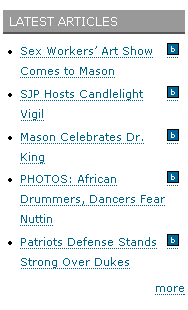>
>Michael Rosenblum’s Wakeup Call to Journalists
November 25th, 2008 · No Comments · Uncategorized
Tags:
>Len Downie: Online standards should match print standards
November 20th, 2008 · No Comments · Uncategorized
>
Leonard Downie, Jr. from Nieman Journalism Lab on Vimeo.
Tags:
>Make Your WordPress Blog Search Engine Friendly
February 5th, 2008 · No Comments · Uncategorized
>
Tags:
>More on RSS
February 5th, 2008 · No Comments · Uncategorized
RSS (Really Simple Syndication)
It’s really simple … seriously.
What is RSS?
RSS (Rich Site Summary) is a format for delivering regularly changing web content. Many news-related sites, weblogs and other online publishers syndicate their content as an RSS Feed to whoever wants it.
Why RSS?
RSS solves a problem for people who regularly use the web. It allows you to easily stay informed by retrieving the latest content from the sites you are interested in. You save time by not needing to visit each site individually. You ensure your privacy, by not needing to join each site’s email newsletter. The number of sites offering RSSfeeds is growing rapidly and includes big names like YahooNews.
What do I need to do to read an RSS Feed?
Feed Reader or News Aggregator software allows you to grab the RSS feeds from various sites and display them for you to read and use.
Try out:
Netvibes
My Yahoo
Google Reader
Feed Reader
Feed Burner
Once you have your Feed Reader, it is a matter of finding sites that syndicate content and adding their RSS feed to the list of feeds your Feed Reader checks. Many sites display a small icon with the acronyms RSS, XML, or RDF to let you know a feed is available.
Put RSS Feeds on your website:
SpringWidgets
Feed Digest
Now just copy the code and paste it into the ‘code’ portion of your site in Dreamweaver. See me if you have any problems.
Worksheet adapted from http://www.whatisrss.com/
Tags:
>Web 2.0: Terms media professional should know
January 28th, 2008 · No Comments · Uncategorized
>
| Web 2.0 Terms Every Media Professional Should Know |
21:25 | 83 MB |
|
http://www.mediabistro.com/21-ondemandvideo.html/ 1. Introduction: What is Web 2.0? Web 2.0 is not a new set of internet standards or protocols, and it is not based on any fresh developments in software or technology. Rather, Web 2.0 represents a change in the way people approach the Internet, and in the strategies and business models used by entrepreneurs to develop user-driven, profit-making online platforms. 2. Web as a Platform During the first phase of the Web, companies were simply taking information that existed outside the Internet and putting it onto their websites. Web 2.0 marks a move to the Web as a platform, with sites that you use and interact with. 3. Architecture of Participation Web 2.0 platforms are user-generated, which means the public contributes dynamic, vital, often uncensored content. 4. Online Community User generated websites where visitors browse and update information create outlets of collective intelligence. 5. Folksonomy A folksonomy is a searchable classification system created by users. 6. Mobility On powerful handheld devices, Web 2.0 travels easily to any location, at any time. 7. The Future of Web 2.0 Where is Web 2.0 headed? Details on how companies can use the unique attributes of Web 2.0 to best advantage. |
Tags:

